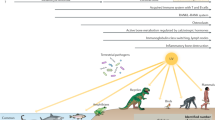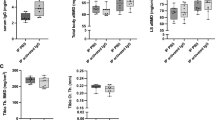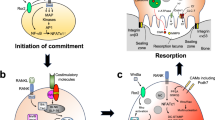Abstract
Inflammation perturbs normal bone homeostasis and is known to induce bone loss, as it promotes both local cartilage degradation and local and systemic bone destruction by osteoclasts, as well as inhibits bone formation by osteoblasts. Thus, not surprisingly, inflammatory autoimmune diseases often lead to local and/or general bone loss. However, the mechanisms that target the bone in autoimmune disease are complex and diverse, as they range from a direct attack on the bone and cartilage by the immune cells to indirect consequences of disturbances of the systemic control of bone remodeling. This Review discusses current understanding of the mechanisms of autoimmune-mediated bone loss in view of new insight from two new fields of research: osteoimmunology, which analyzes the direct effect of immune cells on bone, and the integrative metabolism approach, which established the existence of neuroendocrine loops that regulate bone remodeling.
Key Points
-
Maintenance of bone homeostasis depends on the coupling between the activity of osteoblasts and osteoclasts that is locally regulated by B cells and T cells
-
Bone remodeling is also dependent on regulation by the hypothalamic–pituitary–thyroid axis and a systemic regulatory system that connects bone, the β cells of the pancreas and adipose tissue
-
In inflammatory arthritis—typically rheumatoid arthritis and psoriatic arthritis—bone-localized inflammation directly triggers bone loss
-
In type 1 diabetes mellitus, destruction of β cells disrupts the neuroendocrine regulation between adipose tissue and bone regulation and abolishes the local positive effect of insulin signaling on bone formation
-
In autoimmune thyroid diseases, while hypothyroidism in Hashimoto thyroiditis leads to decreased bone formation, hyperthyroidism in Graves disease stimulates bone destruction; bone mass decreases in both cases
-
In systemic lupus erythematosus, bone loss may be the consequence of the combined effect of systemic inflammation and pro-osteopenic therapeutic adverse effects
This is a preview of subscription content, access via your institution
Access options
Subscribe to this journal
Receive 12 print issues and online access
$209.00 per year
only $17.42 per issue
Buy this article
- Purchase on Springer Link
- Instant access to full article PDF
Prices may be subject to local taxes which are calculated during checkout





Similar content being viewed by others
References
Moser, K., Tokoyoda, K., Radbruch, A., MacLennan, I. & Manz, R. A. Stromal niches, plasma cell differentiation and survival. Curr. Opin. Immunol. 18, 265–270 (2006).
Tokoyoda, K., Hauser, A. E., Nakayama, T. & Radbruch, A. Organization of immunological memory by bone marrow stroma. Nat. Rev. Immunol. 10, 193–200 (2010).
Takayanagi, H. Osteoimmunology and the effects of the immune system on bone. Nat. Rev. Rheumatol. 5, 667–676 (2009).
Lorenzo, J., Horowitz, M. & Choi, Y. Osteoimmunology: interactions of the bone and immune system. Endocr. Rev. 29, 403–440 (2008).
David, J. P. Osteoimmunology: a view from the bone. Adv. Immunol. 95, 149–165 (2007).
McInnes, I. B. & Schett, G. Cytokines in the pathogenesis of rheumatoid arthritis. Nat. Rev. Immunol. 7, 429–442 (2007).
Hartmann, C. Transcriptional networks controlling skeletal development. Curr. Opin. Genet. Dev. 19, 437–443 (2009).
Karsenty, G., Kronenberg, H. M. & Settembre, C. Genetic control of bone formation. Annu. Rev. Cell Dev. Biol. 25, 629–648 (2009).
Takada, I., Kouzmenko, A. P. & Kato, S. Wnt and PPARgamma signaling in osteoblastogenesis and adipogenesis. Nat. Rev. Rheumatol. 5, 442–447 (2009).
Teitelbaum, S. L. & Ross, F. P. Genetic regulation of osteoclast development and function. Nat. Rev. Genet. 4, 638–649 (2003).
Boyle, W. J., Simonet, W. S. & Lacey, D. L. Osteoclast differentiation and activation. Nature 423, 337–342 (2003).
Matsuo, K. & Irie, N. Osteoclast-osteoblast communication. Arch. Biochem. Biophys. 473, 201–209 (2008).
Wada, T., Nakashima, T., Hiroshi, N. & Penninger, J. M. RANKL-RANK signaling in osteoclastogenesis and bone disease. Trends Mol. Med. 12, 17–25 (2006).
Häusler, K. D. et al. Secreted frizzled-related protein-1 inhibits RANKL-dependent osteoclast formation. J. Bone Miner. Res. 19, 1873–1881 (2004).
Zhao, C. et al. Bidirectional ephrinB2-EphB4 signaling controls bone homeostasis. Cell Metab. 4, 111–121 (2006).
Wong, B. R. et al. TRANCE (tumor necrosis factor [TNF]-related activation-induced cytokine), a new TNF family member predominantly expressed in T cells, is a dendritic cell-specific survival factor. J. Exp. Med. 186, 2075–2080 (1997).
Josien, R., Wong, B. R., Li, H. L., Steinman, R. M. & Choi, Y. TRANCE, a TNF family member, is differentially expressed on T cell subsets and induces cytokine production in dendritic cells. J. Immunol. 1 62, 2562–2568 (1999).
Zaiss, M. M. et al. Treg cells suppress osteoclast formation: a new link between the immune system and bone. Arthritis Rheum. 56, 4104–4112 (2007).
Takayanagi, H. et al. T-cell-mediated regulation of osteoclastogenesis by signalling cross-talk between RANKL and IFN-gamma. Nature 408, 600–605 (2000).
Abu-Amer, Y. IL-4 abrogates osteoclastogenesis through STAT6-dependent inhibition of NF-kappaB. J. Clin. Invest. 107, 1375–1385 (2001).
Wei, S., Wang, M. W., Teitelbaum, S. L. & Ross, F. P. Interleukin-4 reversibly inhibits osteoclastogenesis via inhibition of NF-kappa B and mitogen-activated protein kinase signaling. J. Biol. Chem. 277, 6622–6630 (2002).
Moreno, J. L., Kaczmarek, M., Keegan, A. D. & Tondravi, M. IL-4 suppresses osteoclast development and mature osteoclast function by a STAT6-dependent mechanism: irreversible inhibition of the differentiation program activated by RANKL. Blood 102, 1078–1086 (2003).
Axmann, R. et al. CTLA-4 directly inhibits osteoclast formation. Ann. Rheum. Dis. 67, 1603–1609 (2008).
Sato, K. et al. Th17 functions as an osteoclastogenic helper T cell subset that links T cell activation and bone destruction. J. Exp. Med. 203, 2673–2682 (2006).
Kim, Y. G. et al. Human CD4+CD25+ regulatory T cells inhibit the differentiation of osteoclasts from peripheral blood mononuclear cells. Biochem. Biophys. Res. Commun. 357, 1046–1052 (2007).
Choi, Y. et al. Osteoclastogenesis is enhanced by activated B cells but suppressed by activated CD8(+) T cells. Eur. J. Immunol. 31, 2179–2188 (2001).
Grcevic, D. et al. Activated T lymphocytes suppress osteoclastogenesis by diverting early monocyte/macrophage progenitor lineage commitment towards dendritic cell differentiation through down-regulation of receptor activator of nuclear factor-kappaB and c-Fos. Clin. Exp. Immunol. 1 46, 146–158 (2006).
Zaiss, M. M. et al. Increased bone density and resistance to ovariectomy-induced bone loss in FoxP3-transgenic mice based on impaired osteoclast differentiation. Arthritis Rheum. 62, 2328–2338 (2010).
Li, Y. et al. B cells and T cells are critical for the preservation of bone homeostasis and attainment of peak bone mass in vivo. Blood 109, 3839–3848 (2007).
Gao, Y. et al. T cells potentiate PTH-induced cortical bone loss through CD40L signaling. Cell Metab. 8, 132–145 (2008).
Gao, Y. et al. IFN-gamma stimulates osteoclast formation and bone loss in vivo via antigen-driven T cell activation. J. Clin. Invest. 117, 122–132 (2007).
Rosen, C. J. Bone remodeling, energy metabolism, and the molecular clock. Cell Metab. 7, 7–10 (2008).
Lee, N. K. & Karsenty, G. Reciprocal regulation of bone and energy metabolism. J. Musculoskelet. Neuronal Interact. 8, 351 (2008).
Lieben, L., Callewaert, F. & Bouillon, R. Bone and metabolism: a complex crosstalk. Horm. Res. 71 (Suppl. 1), 134–138 (2009).
Hinoi, E. et al. The sympathetic tone mediates leptin's inhibition of insulin secretion by modulating osteocalcin bioactivity. J. Cell Biol. 183, 1235–1242 (2008).
Yoshizawa, T. et al. The transcription factor ATF4 regulates glucose metabolism in mice through its expression in osteoblasts. J. Clin. Invest. 119, 2807–2817 (2009).
Ferron, M., Hinoi, E., Karsenty, G. & Ducy, P. Osteocalcin differentially regulates beta cell and adipocyte gene expression and affects the development of metabolic diseases in wild-type mice. Proc. Natl Acad. Sci. USA 105, 5266–5270 (2008).
Ducy, P. et al. Leptin inhibits bone formation through a hypothalamic relay: a central control of bone mass. Cell 100, 197–207 (2000).
Takeda, S. et al. Leptin regulates bone formation via the sympathetic nervous system. Cell 111, 305–317 (2002).
Fu, L., Patel, M. S., Bradley, A., Wagner, E. F. & Karsenty, G. The molecular clock mediates leptin-regulated bone formation. Cell 122, 803–815 (2005).
Higuchi, H., Hasegawa, A. & Yamaguchi, T. Transcriptional regulation of neuronal genes and its effect on neural functions: transcriptional regulation of neuropeptide Y gene by leptin and its effect on feeding. J. Pharmacol. Sci. 98, 225–231 (2005).
Erickson, J. C., Hollopeter, G. & Palmiter, R. D. Attenuation of the obesity syndrome of ob/ob mice by the loss of neuropeptide Y. Science 274, 1704–1707 (1996).
Baldock, P. A. et al. Hypothalamic Y2 receptors regulate bone formation. J. Clin. Invest. 109, 915–921 (2002).
Baldock, P. A. et al. Novel role of Y1 receptors in the coordinated regulation of bone and energy homeostasis. J. Biol. Chem. 282, 19092–19102 (2007).
Baldock, P. A. et al. Neuropeptide Y knockout mice reveal a central role of NPY in the coordination of bone mass to body weight. PLoS ONE 4, e8415 (2009).
Kuo, L. E. et al. Neuropeptide Y acts directly in the periphery on fat tissue and mediates stress-induced obesity and metabolic syndrome. Nat. Med. 13, 803–811 (2007).
Baldock, P. A. et al. Hypothalamic control of bone formation: distinct actions of leptin and y2 receptor pathways. J. Bone Miner. Res. 20, 1851–1857 (2005).
Baldock, P. A. et al. Hypothalamic regulation of cortical bone mass: opposing activity of Y2 receptor and leptin pathways. J. Bone Miner. Res. 21, 1600–1607 (2006).
Hanada, R. et al. Neuromedin U has a novel anorexigenic effect independent of the leptin signaling pathway. Nat. Med. 10, 1067–1073 (2004).
Sato, S. et al. Central control of bone remodeling by neuromedin U. Nat. Med. 13, 1234–1240 (2007).
Scheller, E. L. et al. Leptin functions peripherally to regulate differentiation of mesenchymal progenitor cells. Stem Cells 28, 1071–1080 (2010).
Bassett, J. H. & Williams, G. R. Critical role of the hypothalamic-pituitary-thyroid axis in bone. Bone 43, 418–426 (2008).
Kunz, M. & Ibrahim, S. M. Cytokines and cytokine profiles in human autoimmune diseases and animal models of autoimmunity. Mediators Inflamm. 2009, 979258 (2009).
Padmos, R. C. et al. Distinct monocyte gene-expression profiles in autoimmune diabetes. Diabetes 57, 2768–2773 (2008).
Devaraj, S. et al. Increased monocytic activity and biomarkers of inflammation in patients with type 1 diabetes. Diabetes 55, 774–779 (2006).
van der Heul-Nieuwenhuijsen, L. et al. An inflammatory gene-expression fingerprint in monocytes of autoimmune thyroid disease patients. J. Clin. Endocrinol. Metab. 95, 1962–1971 (2010).
Riches, P. L. et al. Osteoporosis associated with neutralizing autoantibodies against osteoprotegerin. N. Engl. J. Med. 361, 1459–1465 (2009).
Motyl, K. J. et al. Bone inflammation and altered gene expression with type I diabetes early onset. J. Cell Physiol. 218, 575–583 (2009).
Hueber, A. J. & McInnes, I. B. Immune regulation in psoriasis and psoriatic arthritis—recent developments. Immunol. Lett. 114, 59–65 (2007).
Zenz, R. et al. Psoriasis-like skin disease and arthritis caused by inducible epidermal deletion of Jun proteins. Nature 437, 369–375 (2005).
Boissier, M. C., Assier, E., Falgarone, G. & Bessis, N. Shifting the imbalance from Th1/Th2 to Th17/treg: the changing rheumatoid arthritis paradigm. Joint Bone Spine 7 5, 373–375 (2008).
Nistala, K. & Wedderburn, L. R. Th17 and regulatory T cells: rebalancing pro- and anti-inflammatory forces in autoimmune arthritis. Rheumatology (Oxford) 48, 602–606 (2009).
Zaiss, M. M. et al. Regulatory T cells protect from local and systemic bone destruction in arthritis. J. Immunol. 184, 7238–7246 (2010).
Keffer, J. et al. Transgenic mice expressing human tumour necrosis factor: a predictive genetic model of arthritis. EMBO J. 10, 4025–4031 (1991).
Schett, G. et al. Osteoprotegerin protects against generalized bone loss in tumor necrosis factor-transgenic mice. Arthritis Rheum. 48, 2042–2051 (2003).
David, J. P. & Schett, G. TNF and bone. Curr. Dir Autoimmun. 11, 135–144 (2010).
Eizirik, D. L., Colli, M. L. & Ortis, F. The role of inflammation in insulitis and beta-cell loss in type 1 diabetes. Nat. Rev. Endocrinol. 5, 219–226 (2009).
Huber, A., Menconi, F., Corathers, S., Jacobson, E. M. & Tomer, Y. Joint genetic susceptibility to type 1 diabetes and autoimmune thyroiditis: from epidemiology to mechanisms. Endocr. Rev. 29, 697–725 (2008).
Ounissi-Benkalha, H. & Polychronakos, C. The molecular genetics of type 1 diabetes: new genes and emerging mechanisms. Trends Mol. Med. 14, 268–275 (2008).
Concannon, P., Rich, S. S. & Nepom, G. T. Genetics of type 1A diabetes. N. Engl. J. Med. 360, 1646–1654 (2009).
Pirot, P., Cardozo, A. K. & Eizirik, D. L. Mediators and mechanisms of pancreatic beta-cell death in type 1 diabetes. Arq. Bras. Endocrinol. Metabol. 52, 156–165 (2008).
Schwartz, A. V. Diabetes mellitus: does it affect bone? Calcif. Tissue Int. 73, 515–519 (2003).
Räkel, A., Sheehy, O., Rahme, E. & LeLorier, J. Osteoporosis among patients with type 1 and type 2 diabetes. Diabetes Metab. 34, 193–205 (2008).
Thrailkill, K. M., Lumpkin, C. K. Jr, Bunn, R. C., Kemp, S. F. & Fowlkes, J. L. Is insulin an anabolic agent in bone? Dissecting the diabetic bone for clues. Am. J. Physiol. Endocrinol. Metab. 289, E735–E745 (2005).
McCabe, L. R. Understanding the pathology and mechanisms of type I diabetic bone loss. J. Cell Biochem. 102, 1343–1357 (2007).
Botolin, S. & McCabe, L. R. Bone loss and increased bone adiposity in spontaneous and pharmacologically induced diabetic mice. Endocrinology 148, 198–205 (2007).
Martin, L. M. & McCabe, L. R. Type I diabetic bone phenotype is location but not gender dependent. Histochem. Cell Biol. 128, 125–133 (2007).
Thrailkill, K. M. et al. Bone formation is impaired in a model of type 1 diabetes. Diabetes 54, 2875–2881 (2005).
Irwin, R., Lin, H. V., Motyl, K. J. & McCabe, L. R. Normal bone density obtained in the absence of insulin receptor expression in bone. Endocrinology 14 7, 5760–5767 (2006).
Fulzele, K. et al. Insulin receptor signaling in osteoblasts regulates postnatal bone acquisition and body composition. Cell 142, 309–319 (2010).
Moyer-Mileur, L. J., Slater, H., Jordan, K. C. & Murray, M. A. IGF-1 and IGF-binding proteins and bone mass, geometry, and strength: relation to metabolic control in adolescent girls with type 1 diabetes. J. Bone Miner. Res. 23, 1884–1891 (2008).
Kalra, S. P. Central leptin gene therapy ameliorates diabetes type 1 and 2 through two independent hypothalamic relays; a benefit beyond weight and appetite regulation. Peptides 30, 1957–1963 (2009).
Hamrick, M. W. et al. Leptin treatment induces loss of bone marrow adipocytes and increases bone formation in leptin-deficient ob/ob mice. J. Bone Miner. Res. 20, 994–1001 (2005).
Botolin, S. & McCabe, L. R. Inhibition of PPARgamma prevents type I diabetic bone marrow adiposity but not bone loss. J. Cell Physiol. 20 9, 967–976 (2006).
Motyl, K. J. & McCabe, L. R. Leptin treatment prevents type I diabetic marrow adiposity but not bone loss in mice. J. Cell Physiol. 218, 376–384 (2009).
Van den Driessche, A., Eenkhoorn, V., Van Gaal, L. & De Block, C. Type 1 diabetes and autoimmune polyglandular syndrome: a clinical review. Neth. J. Med. 67, 376–387 (2009).
Michels, A. W. & Eisenbarth, G. S. Immunologic endocrine disorders. J. Allergy Clin. Immunol. 125 (Suppl. 2), S226–S237 (2010).
Vestergaard, P. & Mosekilde, L. Fractures in patients with hyperthyroidism and hypothyroidism: a nationwide follow-up study in 16,249 patients. Thyroid 12, 411–419 (2002).
Abe, E. et al. TSH is a negative regulator of skeletal remodeling. Cell 1 15, 151–162 (2003).
Bassett, J. H. et al. A lack of thyroid hormones rather than excess thyrotropin causes abnormal skeletal development in hypothyroidism. Mol. Endocrinol. 22, 501–512 (2008).
Walsh, N. C., Crotti, T. N., Goldring, S. R. & Gravallese, E. M. Rheumatic diseases: the effects of inflammation on bone. Immunol. Rev. 208, 228–251 (2005).
García-Carrasco, M. et al. Osteoporosis in patients with systemic lupus erythematosus. Isr. Med. Assoc. J. 11, 486–491 (2009).
Sinigaglia, L., Varenna, M., Girasole, G. & Bianchi, G. Epidemiology of osteoporosis in rheumatic diseases. Rheum. Dis. Clin. North Am. 32, 631–658 (2006).
Cutolo, M. & Otsa, K. Review: vitamin D, immunity and lupus. Lupus 17, 6–10 (2008).
Lilleby, V. Bone status in juvenile systemic lupus erythematosus. Lupus 16, 580–586 (2007).
Author information
Authors and Affiliations
Contributions
Both authors contributed to researching data for the article, a substantial contribution to discussion of the content, and to writing the article and reviewing/editing the manuscript before submission.
Corresponding author
Ethics declarations
Competing interests
The authors declare no competing financial interests.
Rights and permissions
About this article
Cite this article
Schett, G., David, JP. The multiple faces of autoimmune-mediated bone loss. Nat Rev Endocrinol 6, 698–706 (2010). https://doi.org/10.1038/nrendo.2010.190
Published:
Issue Date:
DOI: https://doi.org/10.1038/nrendo.2010.190
This article is cited by
-
The association between thyroid hormone changes within the normal range and bone mineral density in patients with type 2 diabetes mellitus
International Journal of Diabetes in Developing Countries (2024)
-
How does Hashimoto’s thyroiditis affect bone metabolism?
Reviews in Endocrine and Metabolic Disorders (2023)
-
Bone Involvement in Patients with Spondyloarthropathies
Calcified Tissue International (2022)
-
Cortical bone loss is an early feature of nonradiographic axial spondyloarthritis
Arthritis Research & Therapy (2018)
-
Competing Factors Link to Bone Health in Polycystic Ovary Syndrome: Chronic Low-Grade Inflammation Takes a Toll
Scientific Reports (2017)



